MMS711 Essay: Exploring the Future of Australian Sports Management
VerifiedAdded on 2023/06/11
|30
|8781
|474
Essay
AI Summary
This essay provides a comprehensive analysis of the Australian sports system, focusing on the four pyramids that have shaped its organization, management, and overall structure. It critically evaluates the utility of these pyramids – the traditional sports system, corporate sport, government systems, and sport development – while examining the impact of sports management and delivery in light of evolving models of sport creation and sport clusters. The essay highlights the challenges faced by Australian sports, particularly in managing success and providing adequate facilities, emphasizing the need for effective communication between local governments, clubs, and associations. It also delves into the historical evolution of Australian sports, discussing the influence of commercial interests, government support programs like the AIS, and the importance of balancing elite athlete development with grassroots participation. The analysis considers the strengths and weaknesses of each pyramid, such as the traditional system's mass participation focus versus its management inefficiencies, and the government's role in funding and program development. Ultimately, the essay offers insights into the future of Australian sports management and the factors critical to its success. Desklib provides a platform to explore more such solved assignments and past papers.
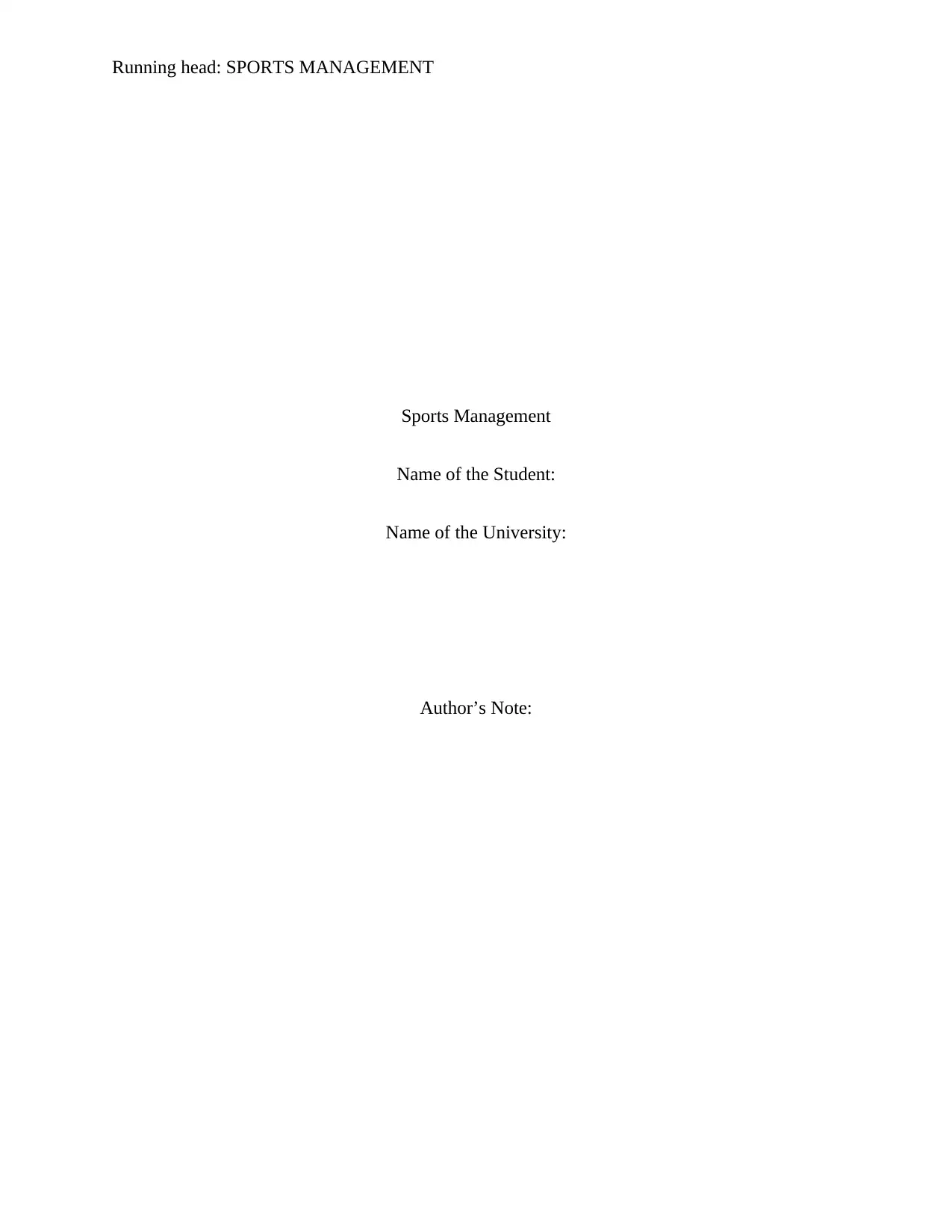
Running head: SPORTS MANAGEMENT
Sports Management
Name of the Student:
Name of the University:
Author’s Note:
Sports Management
Name of the Student:
Name of the University:
Author’s Note:
Paraphrase This Document
Need a fresh take? Get an instant paraphrase of this document with our AI Paraphraser
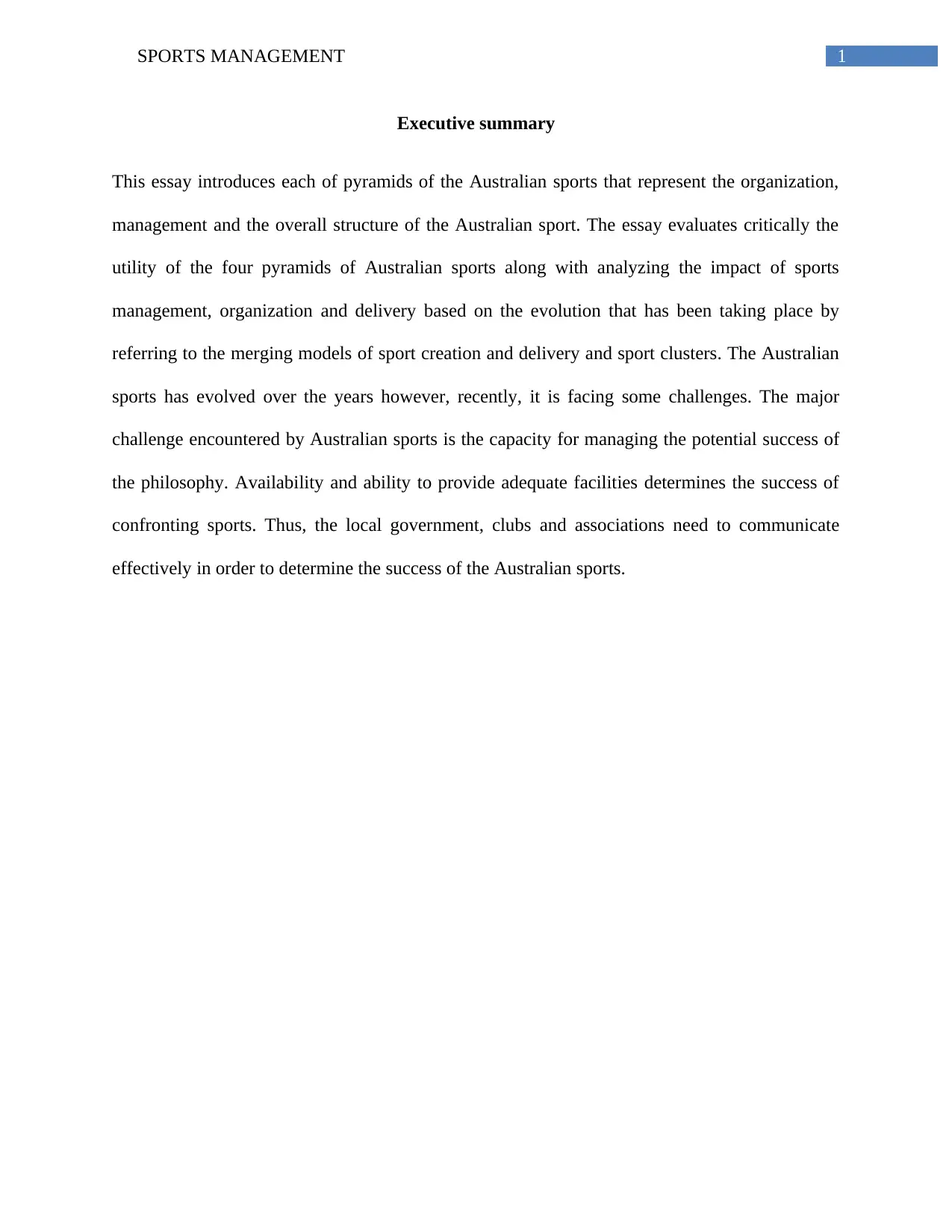
1SPORTS MANAGEMENT
Executive summary
This essay introduces each of pyramids of the Australian sports that represent the organization,
management and the overall structure of the Australian sport. The essay evaluates critically the
utility of the four pyramids of Australian sports along with analyzing the impact of sports
management, organization and delivery based on the evolution that has been taking place by
referring to the merging models of sport creation and delivery and sport clusters. The Australian
sports has evolved over the years however, recently, it is facing some challenges. The major
challenge encountered by Australian sports is the capacity for managing the potential success of
the philosophy. Availability and ability to provide adequate facilities determines the success of
confronting sports. Thus, the local government, clubs and associations need to communicate
effectively in order to determine the success of the Australian sports.
Executive summary
This essay introduces each of pyramids of the Australian sports that represent the organization,
management and the overall structure of the Australian sport. The essay evaluates critically the
utility of the four pyramids of Australian sports along with analyzing the impact of sports
management, organization and delivery based on the evolution that has been taking place by
referring to the merging models of sport creation and delivery and sport clusters. The Australian
sports has evolved over the years however, recently, it is facing some challenges. The major
challenge encountered by Australian sports is the capacity for managing the potential success of
the philosophy. Availability and ability to provide adequate facilities determines the success of
confronting sports. Thus, the local government, clubs and associations need to communicate
effectively in order to determine the success of the Australian sports.
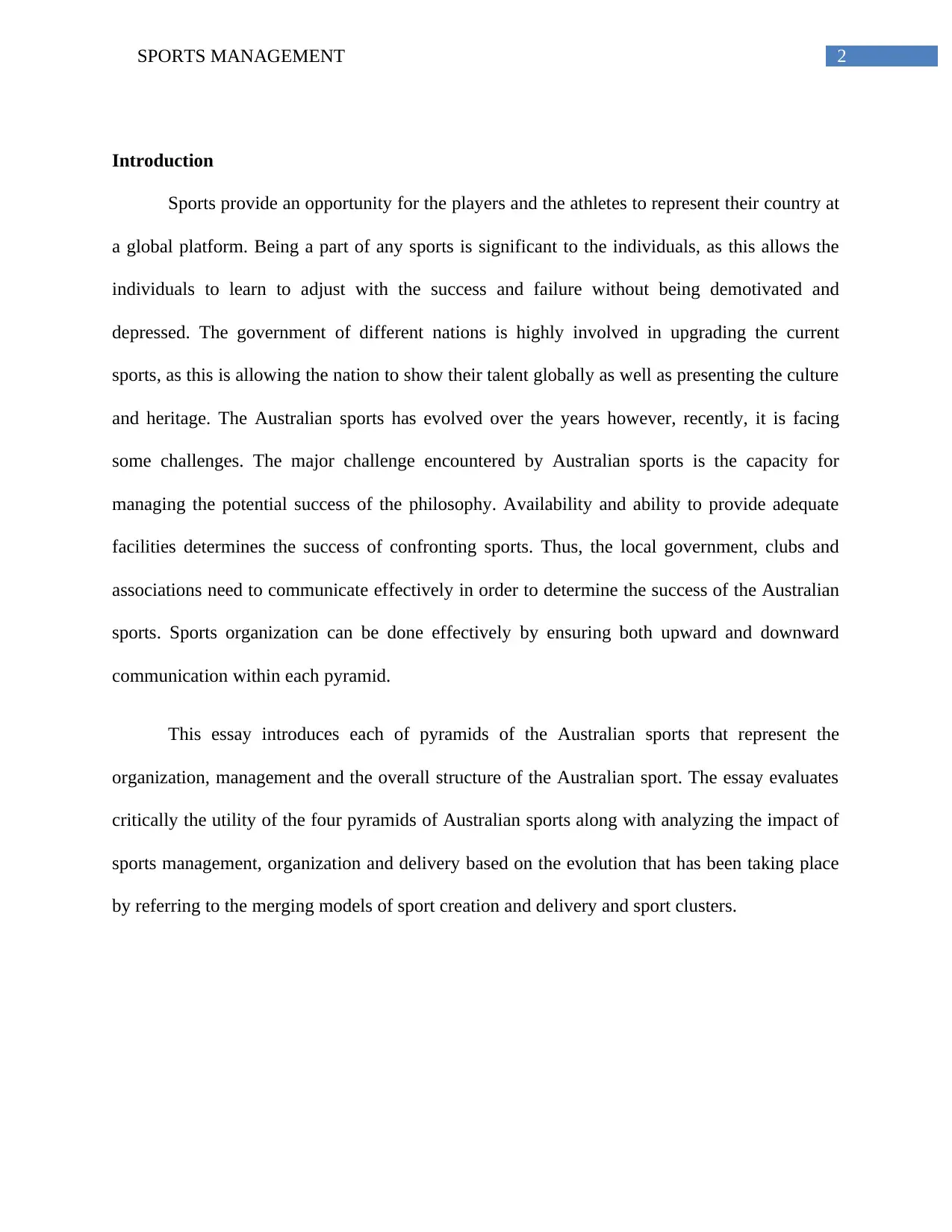
2SPORTS MANAGEMENT
Introduction
Sports provide an opportunity for the players and the athletes to represent their country at
a global platform. Being a part of any sports is significant to the individuals, as this allows the
individuals to learn to adjust with the success and failure without being demotivated and
depressed. The government of different nations is highly involved in upgrading the current
sports, as this is allowing the nation to show their talent globally as well as presenting the culture
and heritage. The Australian sports has evolved over the years however, recently, it is facing
some challenges. The major challenge encountered by Australian sports is the capacity for
managing the potential success of the philosophy. Availability and ability to provide adequate
facilities determines the success of confronting sports. Thus, the local government, clubs and
associations need to communicate effectively in order to determine the success of the Australian
sports. Sports organization can be done effectively by ensuring both upward and downward
communication within each pyramid.
This essay introduces each of pyramids of the Australian sports that represent the
organization, management and the overall structure of the Australian sport. The essay evaluates
critically the utility of the four pyramids of Australian sports along with analyzing the impact of
sports management, organization and delivery based on the evolution that has been taking place
by referring to the merging models of sport creation and delivery and sport clusters.
Introduction
Sports provide an opportunity for the players and the athletes to represent their country at
a global platform. Being a part of any sports is significant to the individuals, as this allows the
individuals to learn to adjust with the success and failure without being demotivated and
depressed. The government of different nations is highly involved in upgrading the current
sports, as this is allowing the nation to show their talent globally as well as presenting the culture
and heritage. The Australian sports has evolved over the years however, recently, it is facing
some challenges. The major challenge encountered by Australian sports is the capacity for
managing the potential success of the philosophy. Availability and ability to provide adequate
facilities determines the success of confronting sports. Thus, the local government, clubs and
associations need to communicate effectively in order to determine the success of the Australian
sports. Sports organization can be done effectively by ensuring both upward and downward
communication within each pyramid.
This essay introduces each of pyramids of the Australian sports that represent the
organization, management and the overall structure of the Australian sport. The essay evaluates
critically the utility of the four pyramids of Australian sports along with analyzing the impact of
sports management, organization and delivery based on the evolution that has been taking place
by referring to the merging models of sport creation and delivery and sport clusters.
⊘ This is a preview!⊘
Do you want full access?
Subscribe today to unlock all pages.

Trusted by 1+ million students worldwide
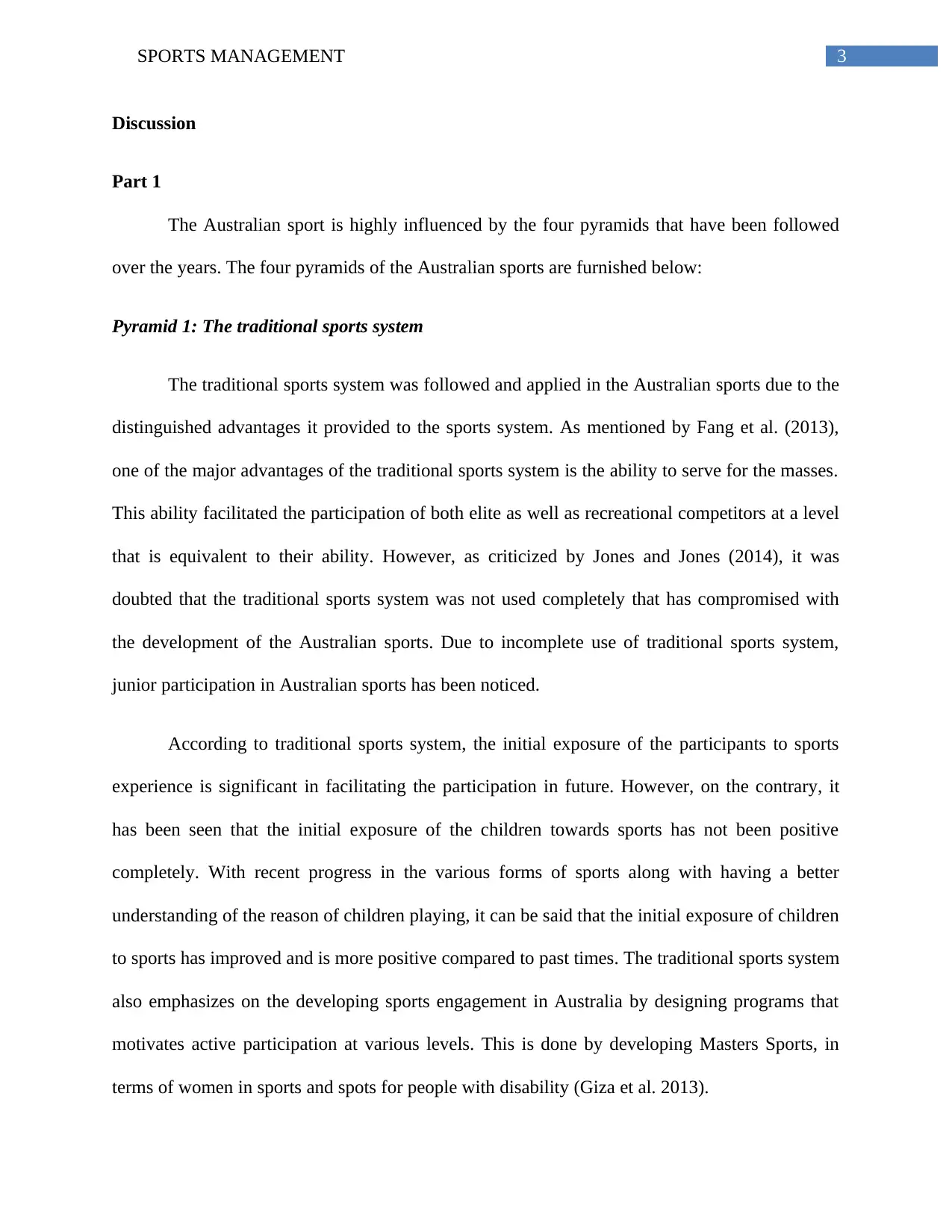
3SPORTS MANAGEMENT
Discussion
Part 1
The Australian sport is highly influenced by the four pyramids that have been followed
over the years. The four pyramids of the Australian sports are furnished below:
Pyramid 1: The traditional sports system
The traditional sports system was followed and applied in the Australian sports due to the
distinguished advantages it provided to the sports system. As mentioned by Fang et al. (2013),
one of the major advantages of the traditional sports system is the ability to serve for the masses.
This ability facilitated the participation of both elite as well as recreational competitors at a level
that is equivalent to their ability. However, as criticized by Jones and Jones (2014), it was
doubted that the traditional sports system was not used completely that has compromised with
the development of the Australian sports. Due to incomplete use of traditional sports system,
junior participation in Australian sports has been noticed.
According to traditional sports system, the initial exposure of the participants to sports
experience is significant in facilitating the participation in future. However, on the contrary, it
has been seen that the initial exposure of the children towards sports has not been positive
completely. With recent progress in the various forms of sports along with having a better
understanding of the reason of children playing, it can be said that the initial exposure of children
to sports has improved and is more positive compared to past times. The traditional sports system
also emphasizes on the developing sports engagement in Australia by designing programs that
motivates active participation at various levels. This is done by developing Masters Sports, in
terms of women in sports and spots for people with disability (Giza et al. 2013).
Discussion
Part 1
The Australian sport is highly influenced by the four pyramids that have been followed
over the years. The four pyramids of the Australian sports are furnished below:
Pyramid 1: The traditional sports system
The traditional sports system was followed and applied in the Australian sports due to the
distinguished advantages it provided to the sports system. As mentioned by Fang et al. (2013),
one of the major advantages of the traditional sports system is the ability to serve for the masses.
This ability facilitated the participation of both elite as well as recreational competitors at a level
that is equivalent to their ability. However, as criticized by Jones and Jones (2014), it was
doubted that the traditional sports system was not used completely that has compromised with
the development of the Australian sports. Due to incomplete use of traditional sports system,
junior participation in Australian sports has been noticed.
According to traditional sports system, the initial exposure of the participants to sports
experience is significant in facilitating the participation in future. However, on the contrary, it
has been seen that the initial exposure of the children towards sports has not been positive
completely. With recent progress in the various forms of sports along with having a better
understanding of the reason of children playing, it can be said that the initial exposure of children
to sports has improved and is more positive compared to past times. The traditional sports system
also emphasizes on the developing sports engagement in Australia by designing programs that
motivates active participation at various levels. This is done by developing Masters Sports, in
terms of women in sports and spots for people with disability (Giza et al. 2013).
Paraphrase This Document
Need a fresh take? Get an instant paraphrase of this document with our AI Paraphraser
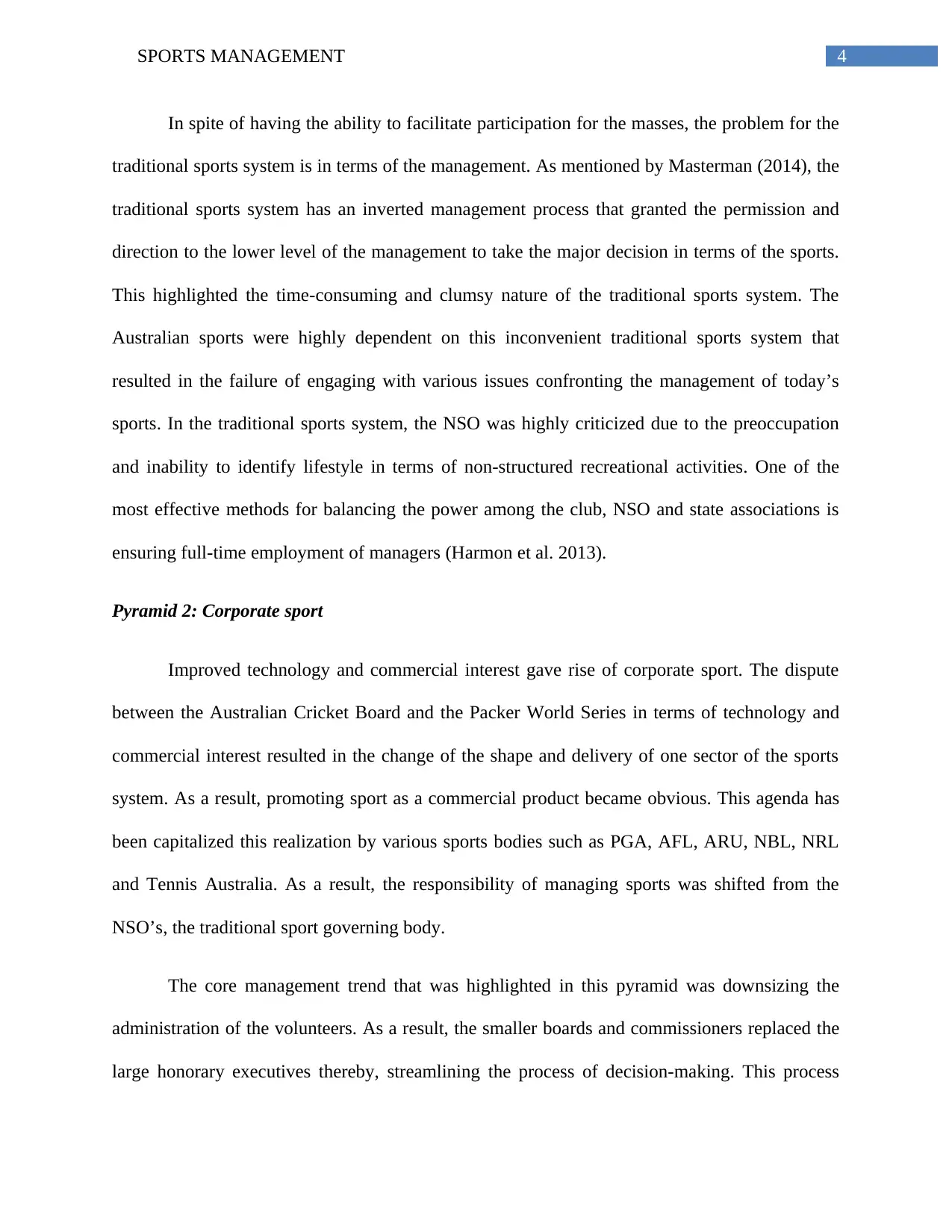
4SPORTS MANAGEMENT
In spite of having the ability to facilitate participation for the masses, the problem for the
traditional sports system is in terms of the management. As mentioned by Masterman (2014), the
traditional sports system has an inverted management process that granted the permission and
direction to the lower level of the management to take the major decision in terms of the sports.
This highlighted the time-consuming and clumsy nature of the traditional sports system. The
Australian sports were highly dependent on this inconvenient traditional sports system that
resulted in the failure of engaging with various issues confronting the management of today’s
sports. In the traditional sports system, the NSO was highly criticized due to the preoccupation
and inability to identify lifestyle in terms of non-structured recreational activities. One of the
most effective methods for balancing the power among the club, NSO and state associations is
ensuring full-time employment of managers (Harmon et al. 2013).
Pyramid 2: Corporate sport
Improved technology and commercial interest gave rise of corporate sport. The dispute
between the Australian Cricket Board and the Packer World Series in terms of technology and
commercial interest resulted in the change of the shape and delivery of one sector of the sports
system. As a result, promoting sport as a commercial product became obvious. This agenda has
been capitalized this realization by various sports bodies such as PGA, AFL, ARU, NBL, NRL
and Tennis Australia. As a result, the responsibility of managing sports was shifted from the
NSO’s, the traditional sport governing body.
The core management trend that was highlighted in this pyramid was downsizing the
administration of the volunteers. As a result, the smaller boards and commissioners replaced the
large honorary executives thereby, streamlining the process of decision-making. This process
In spite of having the ability to facilitate participation for the masses, the problem for the
traditional sports system is in terms of the management. As mentioned by Masterman (2014), the
traditional sports system has an inverted management process that granted the permission and
direction to the lower level of the management to take the major decision in terms of the sports.
This highlighted the time-consuming and clumsy nature of the traditional sports system. The
Australian sports were highly dependent on this inconvenient traditional sports system that
resulted in the failure of engaging with various issues confronting the management of today’s
sports. In the traditional sports system, the NSO was highly criticized due to the preoccupation
and inability to identify lifestyle in terms of non-structured recreational activities. One of the
most effective methods for balancing the power among the club, NSO and state associations is
ensuring full-time employment of managers (Harmon et al. 2013).
Pyramid 2: Corporate sport
Improved technology and commercial interest gave rise of corporate sport. The dispute
between the Australian Cricket Board and the Packer World Series in terms of technology and
commercial interest resulted in the change of the shape and delivery of one sector of the sports
system. As a result, promoting sport as a commercial product became obvious. This agenda has
been capitalized this realization by various sports bodies such as PGA, AFL, ARU, NBL, NRL
and Tennis Australia. As a result, the responsibility of managing sports was shifted from the
NSO’s, the traditional sport governing body.
The core management trend that was highlighted in this pyramid was downsizing the
administration of the volunteers. As a result, the smaller boards and commissioners replaced the
large honorary executives thereby, streamlining the process of decision-making. This process
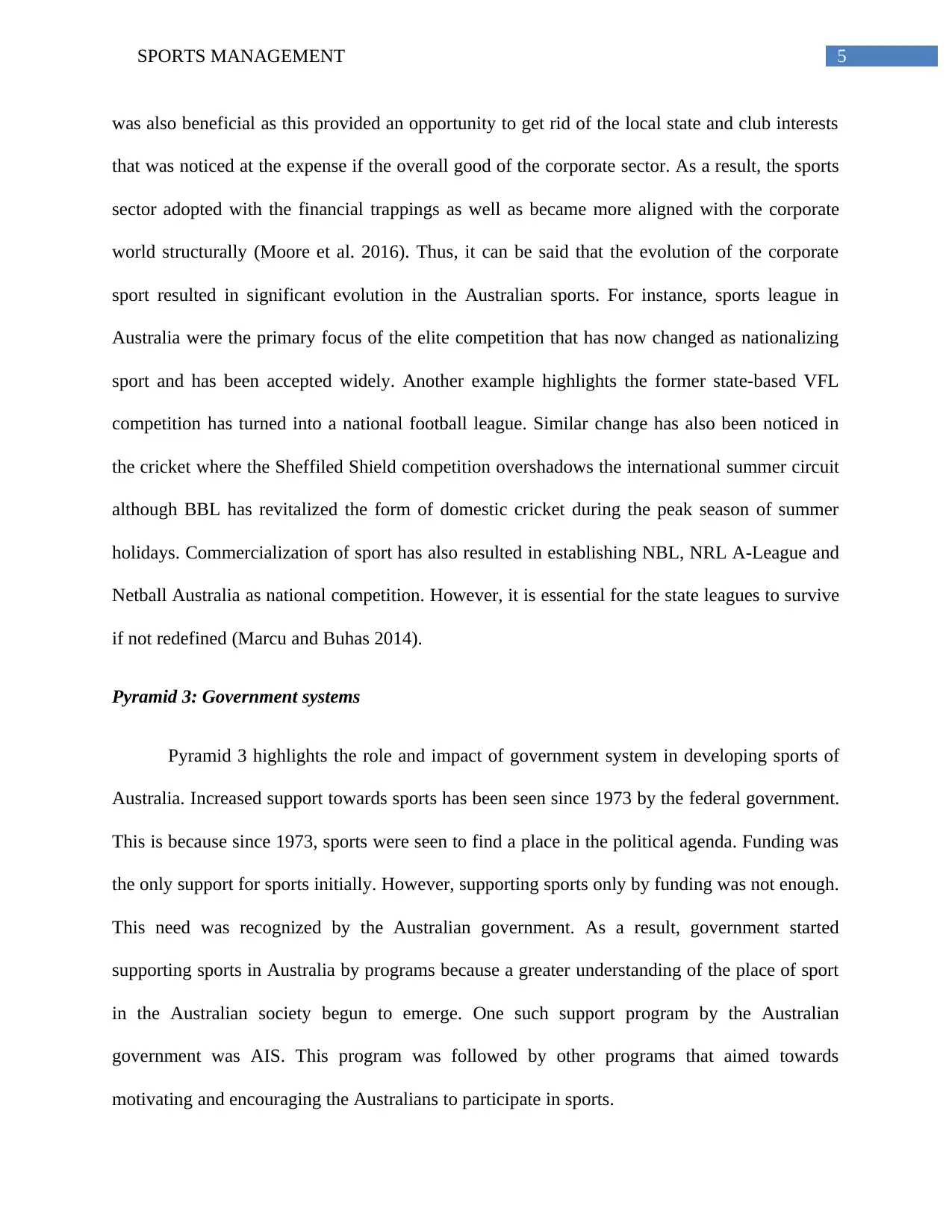
5SPORTS MANAGEMENT
was also beneficial as this provided an opportunity to get rid of the local state and club interests
that was noticed at the expense if the overall good of the corporate sector. As a result, the sports
sector adopted with the financial trappings as well as became more aligned with the corporate
world structurally (Moore et al. 2016). Thus, it can be said that the evolution of the corporate
sport resulted in significant evolution in the Australian sports. For instance, sports league in
Australia were the primary focus of the elite competition that has now changed as nationalizing
sport and has been accepted widely. Another example highlights the former state-based VFL
competition has turned into a national football league. Similar change has also been noticed in
the cricket where the Sheffiled Shield competition overshadows the international summer circuit
although BBL has revitalized the form of domestic cricket during the peak season of summer
holidays. Commercialization of sport has also resulted in establishing NBL, NRL A-League and
Netball Australia as national competition. However, it is essential for the state leagues to survive
if not redefined (Marcu and Buhas 2014).
Pyramid 3: Government systems
Pyramid 3 highlights the role and impact of government system in developing sports of
Australia. Increased support towards sports has been seen since 1973 by the federal government.
This is because since 1973, sports were seen to find a place in the political agenda. Funding was
the only support for sports initially. However, supporting sports only by funding was not enough.
This need was recognized by the Australian government. As a result, government started
supporting sports in Australia by programs because a greater understanding of the place of sport
in the Australian society begun to emerge. One such support program by the Australian
government was AIS. This program was followed by other programs that aimed towards
motivating and encouraging the Australians to participate in sports.
was also beneficial as this provided an opportunity to get rid of the local state and club interests
that was noticed at the expense if the overall good of the corporate sector. As a result, the sports
sector adopted with the financial trappings as well as became more aligned with the corporate
world structurally (Moore et al. 2016). Thus, it can be said that the evolution of the corporate
sport resulted in significant evolution in the Australian sports. For instance, sports league in
Australia were the primary focus of the elite competition that has now changed as nationalizing
sport and has been accepted widely. Another example highlights the former state-based VFL
competition has turned into a national football league. Similar change has also been noticed in
the cricket where the Sheffiled Shield competition overshadows the international summer circuit
although BBL has revitalized the form of domestic cricket during the peak season of summer
holidays. Commercialization of sport has also resulted in establishing NBL, NRL A-League and
Netball Australia as national competition. However, it is essential for the state leagues to survive
if not redefined (Marcu and Buhas 2014).
Pyramid 3: Government systems
Pyramid 3 highlights the role and impact of government system in developing sports of
Australia. Increased support towards sports has been seen since 1973 by the federal government.
This is because since 1973, sports were seen to find a place in the political agenda. Funding was
the only support for sports initially. However, supporting sports only by funding was not enough.
This need was recognized by the Australian government. As a result, government started
supporting sports in Australia by programs because a greater understanding of the place of sport
in the Australian society begun to emerge. One such support program by the Australian
government was AIS. This program was followed by other programs that aimed towards
motivating and encouraging the Australians to participate in sports.
⊘ This is a preview!⊘
Do you want full access?
Subscribe today to unlock all pages.

Trusted by 1+ million students worldwide
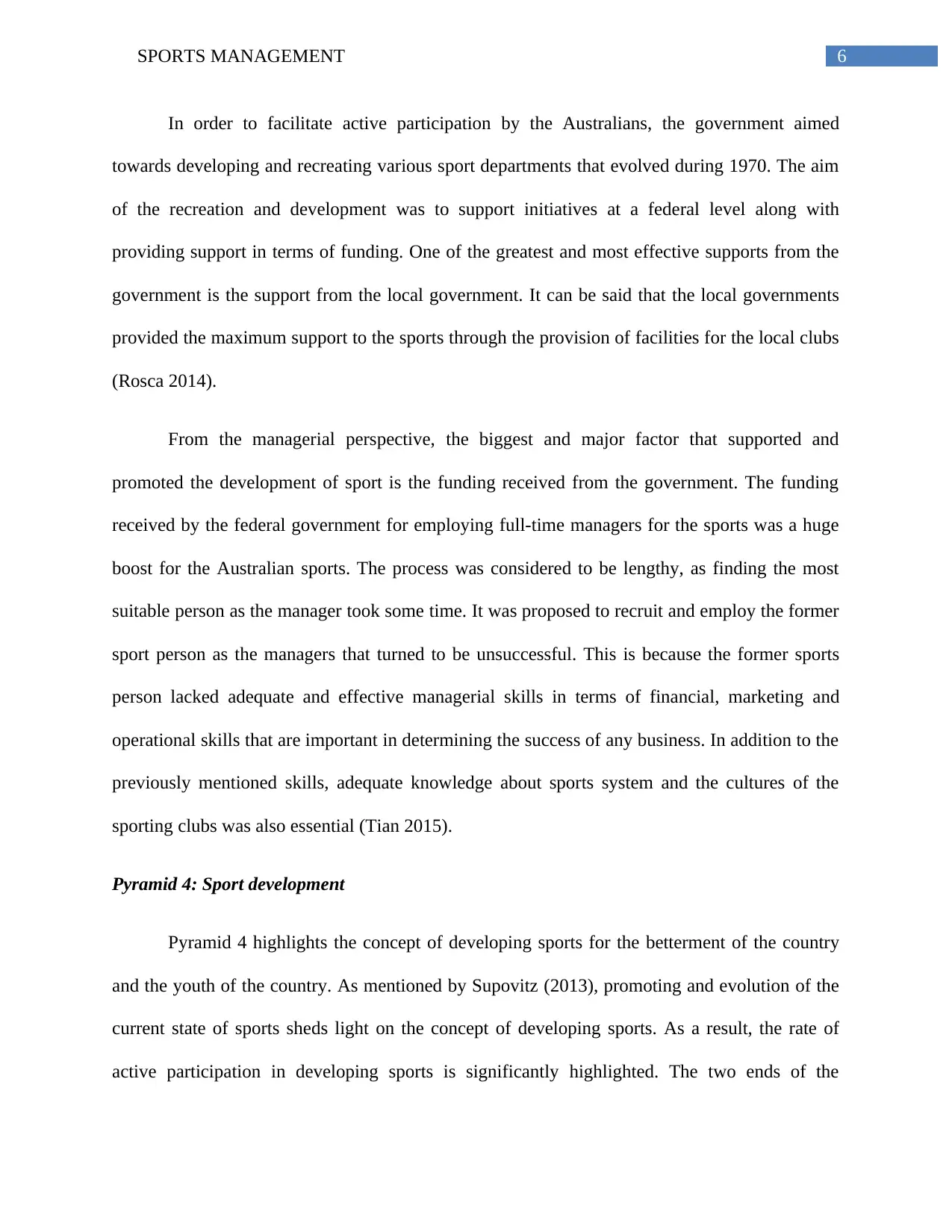
6SPORTS MANAGEMENT
In order to facilitate active participation by the Australians, the government aimed
towards developing and recreating various sport departments that evolved during 1970. The aim
of the recreation and development was to support initiatives at a federal level along with
providing support in terms of funding. One of the greatest and most effective supports from the
government is the support from the local government. It can be said that the local governments
provided the maximum support to the sports through the provision of facilities for the local clubs
(Rosca 2014).
From the managerial perspective, the biggest and major factor that supported and
promoted the development of sport is the funding received from the government. The funding
received by the federal government for employing full-time managers for the sports was a huge
boost for the Australian sports. The process was considered to be lengthy, as finding the most
suitable person as the manager took some time. It was proposed to recruit and employ the former
sport person as the managers that turned to be unsuccessful. This is because the former sports
person lacked adequate and effective managerial skills in terms of financial, marketing and
operational skills that are important in determining the success of any business. In addition to the
previously mentioned skills, adequate knowledge about sports system and the cultures of the
sporting clubs was also essential (Tian 2015).
Pyramid 4: Sport development
Pyramid 4 highlights the concept of developing sports for the betterment of the country
and the youth of the country. As mentioned by Supovitz (2013), promoting and evolution of the
current state of sports sheds light on the concept of developing sports. As a result, the rate of
active participation in developing sports is significantly highlighted. The two ends of the
In order to facilitate active participation by the Australians, the government aimed
towards developing and recreating various sport departments that evolved during 1970. The aim
of the recreation and development was to support initiatives at a federal level along with
providing support in terms of funding. One of the greatest and most effective supports from the
government is the support from the local government. It can be said that the local governments
provided the maximum support to the sports through the provision of facilities for the local clubs
(Rosca 2014).
From the managerial perspective, the biggest and major factor that supported and
promoted the development of sport is the funding received from the government. The funding
received by the federal government for employing full-time managers for the sports was a huge
boost for the Australian sports. The process was considered to be lengthy, as finding the most
suitable person as the manager took some time. It was proposed to recruit and employ the former
sport person as the managers that turned to be unsuccessful. This is because the former sports
person lacked adequate and effective managerial skills in terms of financial, marketing and
operational skills that are important in determining the success of any business. In addition to the
previously mentioned skills, adequate knowledge about sports system and the cultures of the
sporting clubs was also essential (Tian 2015).
Pyramid 4: Sport development
Pyramid 4 highlights the concept of developing sports for the betterment of the country
and the youth of the country. As mentioned by Supovitz (2013), promoting and evolution of the
current state of sports sheds light on the concept of developing sports. As a result, the rate of
active participation in developing sports is significantly highlighted. The two ends of the
Paraphrase This Document
Need a fresh take? Get an instant paraphrase of this document with our AI Paraphraser
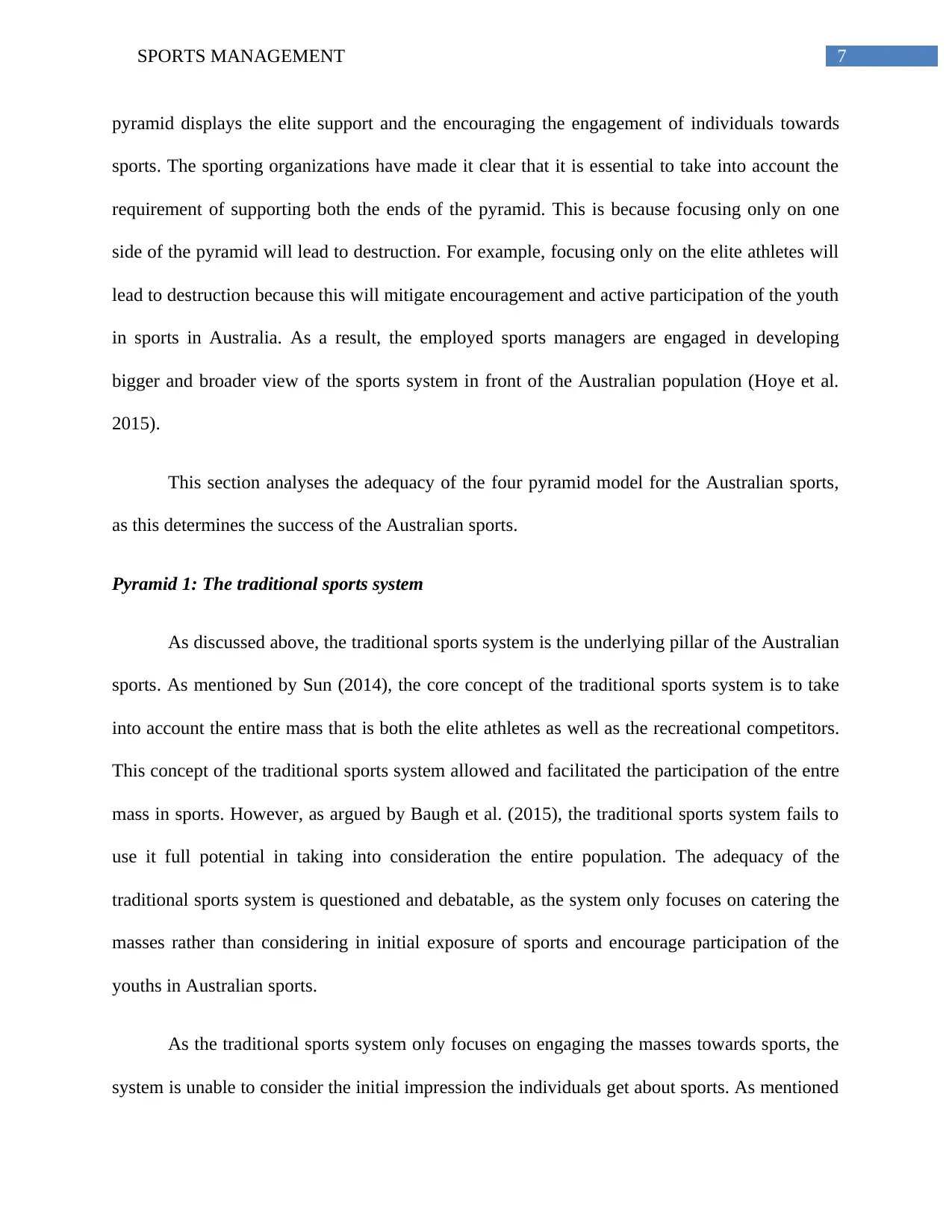
7SPORTS MANAGEMENT
pyramid displays the elite support and the encouraging the engagement of individuals towards
sports. The sporting organizations have made it clear that it is essential to take into account the
requirement of supporting both the ends of the pyramid. This is because focusing only on one
side of the pyramid will lead to destruction. For example, focusing only on the elite athletes will
lead to destruction because this will mitigate encouragement and active participation of the youth
in sports in Australia. As a result, the employed sports managers are engaged in developing
bigger and broader view of the sports system in front of the Australian population (Hoye et al.
2015).
This section analyses the adequacy of the four pyramid model for the Australian sports,
as this determines the success of the Australian sports.
Pyramid 1: The traditional sports system
As discussed above, the traditional sports system is the underlying pillar of the Australian
sports. As mentioned by Sun (2014), the core concept of the traditional sports system is to take
into account the entire mass that is both the elite athletes as well as the recreational competitors.
This concept of the traditional sports system allowed and facilitated the participation of the entre
mass in sports. However, as argued by Baugh et al. (2015), the traditional sports system fails to
use it full potential in taking into consideration the entire population. The adequacy of the
traditional sports system is questioned and debatable, as the system only focuses on catering the
masses rather than considering in initial exposure of sports and encourage participation of the
youths in Australian sports.
As the traditional sports system only focuses on engaging the masses towards sports, the
system is unable to consider the initial impression the individuals get about sports. As mentioned
pyramid displays the elite support and the encouraging the engagement of individuals towards
sports. The sporting organizations have made it clear that it is essential to take into account the
requirement of supporting both the ends of the pyramid. This is because focusing only on one
side of the pyramid will lead to destruction. For example, focusing only on the elite athletes will
lead to destruction because this will mitigate encouragement and active participation of the youth
in sports in Australia. As a result, the employed sports managers are engaged in developing
bigger and broader view of the sports system in front of the Australian population (Hoye et al.
2015).
This section analyses the adequacy of the four pyramid model for the Australian sports,
as this determines the success of the Australian sports.
Pyramid 1: The traditional sports system
As discussed above, the traditional sports system is the underlying pillar of the Australian
sports. As mentioned by Sun (2014), the core concept of the traditional sports system is to take
into account the entire mass that is both the elite athletes as well as the recreational competitors.
This concept of the traditional sports system allowed and facilitated the participation of the entre
mass in sports. However, as argued by Baugh et al. (2015), the traditional sports system fails to
use it full potential in taking into consideration the entire population. The adequacy of the
traditional sports system is questioned and debatable, as the system only focuses on catering the
masses rather than considering in initial exposure of sports and encourage participation of the
youths in Australian sports.
As the traditional sports system only focuses on engaging the masses towards sports, the
system is unable to consider the initial impression the individuals get about sports. As mentioned
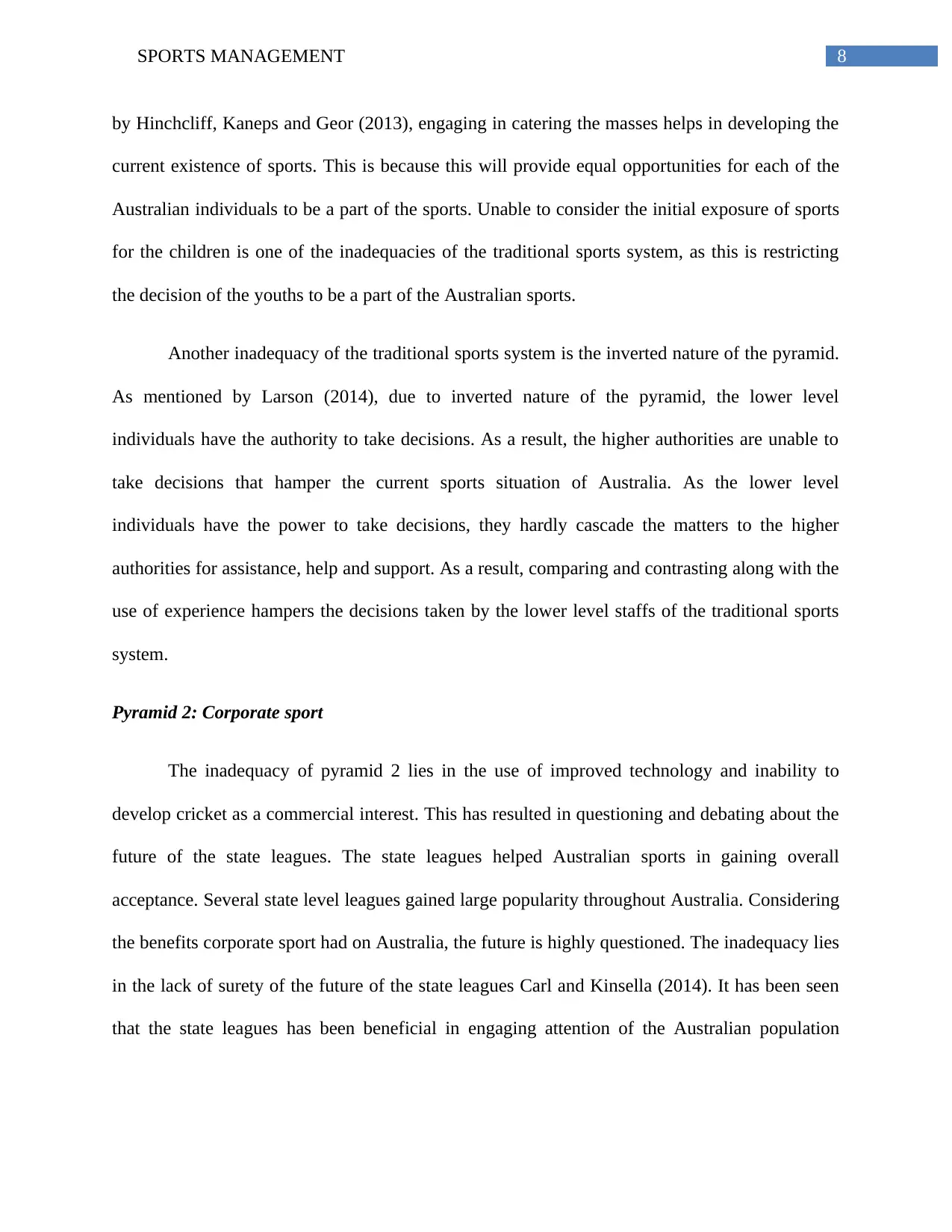
8SPORTS MANAGEMENT
by Hinchcliff, Kaneps and Geor (2013), engaging in catering the masses helps in developing the
current existence of sports. This is because this will provide equal opportunities for each of the
Australian individuals to be a part of the sports. Unable to consider the initial exposure of sports
for the children is one of the inadequacies of the traditional sports system, as this is restricting
the decision of the youths to be a part of the Australian sports.
Another inadequacy of the traditional sports system is the inverted nature of the pyramid.
As mentioned by Larson (2014), due to inverted nature of the pyramid, the lower level
individuals have the authority to take decisions. As a result, the higher authorities are unable to
take decisions that hamper the current sports situation of Australia. As the lower level
individuals have the power to take decisions, they hardly cascade the matters to the higher
authorities for assistance, help and support. As a result, comparing and contrasting along with the
use of experience hampers the decisions taken by the lower level staffs of the traditional sports
system.
Pyramid 2: Corporate sport
The inadequacy of pyramid 2 lies in the use of improved technology and inability to
develop cricket as a commercial interest. This has resulted in questioning and debating about the
future of the state leagues. The state leagues helped Australian sports in gaining overall
acceptance. Several state level leagues gained large popularity throughout Australia. Considering
the benefits corporate sport had on Australia, the future is highly questioned. The inadequacy lies
in the lack of surety of the future of the state leagues Carl and Kinsella (2014). It has been seen
that the state leagues has been beneficial in engaging attention of the Australian population
by Hinchcliff, Kaneps and Geor (2013), engaging in catering the masses helps in developing the
current existence of sports. This is because this will provide equal opportunities for each of the
Australian individuals to be a part of the sports. Unable to consider the initial exposure of sports
for the children is one of the inadequacies of the traditional sports system, as this is restricting
the decision of the youths to be a part of the Australian sports.
Another inadequacy of the traditional sports system is the inverted nature of the pyramid.
As mentioned by Larson (2014), due to inverted nature of the pyramid, the lower level
individuals have the authority to take decisions. As a result, the higher authorities are unable to
take decisions that hamper the current sports situation of Australia. As the lower level
individuals have the power to take decisions, they hardly cascade the matters to the higher
authorities for assistance, help and support. As a result, comparing and contrasting along with the
use of experience hampers the decisions taken by the lower level staffs of the traditional sports
system.
Pyramid 2: Corporate sport
The inadequacy of pyramid 2 lies in the use of improved technology and inability to
develop cricket as a commercial interest. This has resulted in questioning and debating about the
future of the state leagues. The state leagues helped Australian sports in gaining overall
acceptance. Several state level leagues gained large popularity throughout Australia. Considering
the benefits corporate sport had on Australia, the future is highly questioned. The inadequacy lies
in the lack of surety of the future of the state leagues Carl and Kinsella (2014). It has been seen
that the state leagues has been beneficial in engaging attention of the Australian population
⊘ This is a preview!⊘
Do you want full access?
Subscribe today to unlock all pages.

Trusted by 1+ million students worldwide
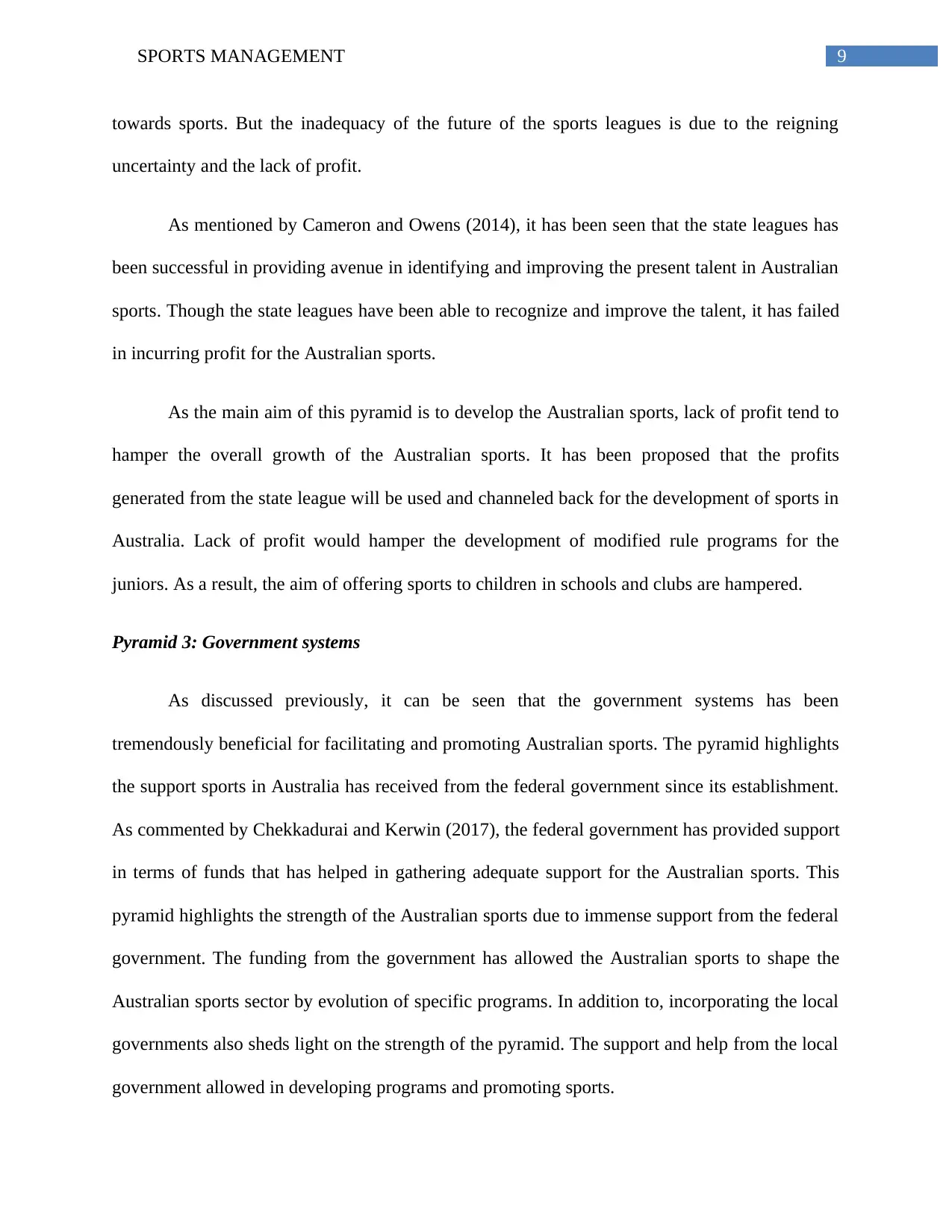
9SPORTS MANAGEMENT
towards sports. But the inadequacy of the future of the sports leagues is due to the reigning
uncertainty and the lack of profit.
As mentioned by Cameron and Owens (2014), it has been seen that the state leagues has
been successful in providing avenue in identifying and improving the present talent in Australian
sports. Though the state leagues have been able to recognize and improve the talent, it has failed
in incurring profit for the Australian sports.
As the main aim of this pyramid is to develop the Australian sports, lack of profit tend to
hamper the overall growth of the Australian sports. It has been proposed that the profits
generated from the state league will be used and channeled back for the development of sports in
Australia. Lack of profit would hamper the development of modified rule programs for the
juniors. As a result, the aim of offering sports to children in schools and clubs are hampered.
Pyramid 3: Government systems
As discussed previously, it can be seen that the government systems has been
tremendously beneficial for facilitating and promoting Australian sports. The pyramid highlights
the support sports in Australia has received from the federal government since its establishment.
As commented by Chekkadurai and Kerwin (2017), the federal government has provided support
in terms of funds that has helped in gathering adequate support for the Australian sports. This
pyramid highlights the strength of the Australian sports due to immense support from the federal
government. The funding from the government has allowed the Australian sports to shape the
Australian sports sector by evolution of specific programs. In addition to, incorporating the local
governments also sheds light on the strength of the pyramid. The support and help from the local
government allowed in developing programs and promoting sports.
towards sports. But the inadequacy of the future of the sports leagues is due to the reigning
uncertainty and the lack of profit.
As mentioned by Cameron and Owens (2014), it has been seen that the state leagues has
been successful in providing avenue in identifying and improving the present talent in Australian
sports. Though the state leagues have been able to recognize and improve the talent, it has failed
in incurring profit for the Australian sports.
As the main aim of this pyramid is to develop the Australian sports, lack of profit tend to
hamper the overall growth of the Australian sports. It has been proposed that the profits
generated from the state league will be used and channeled back for the development of sports in
Australia. Lack of profit would hamper the development of modified rule programs for the
juniors. As a result, the aim of offering sports to children in schools and clubs are hampered.
Pyramid 3: Government systems
As discussed previously, it can be seen that the government systems has been
tremendously beneficial for facilitating and promoting Australian sports. The pyramid highlights
the support sports in Australia has received from the federal government since its establishment.
As commented by Chekkadurai and Kerwin (2017), the federal government has provided support
in terms of funds that has helped in gathering adequate support for the Australian sports. This
pyramid highlights the strength of the Australian sports due to immense support from the federal
government. The funding from the government has allowed the Australian sports to shape the
Australian sports sector by evolution of specific programs. In addition to, incorporating the local
governments also sheds light on the strength of the pyramid. The support and help from the local
government allowed in developing programs and promoting sports.
Paraphrase This Document
Need a fresh take? Get an instant paraphrase of this document with our AI Paraphraser
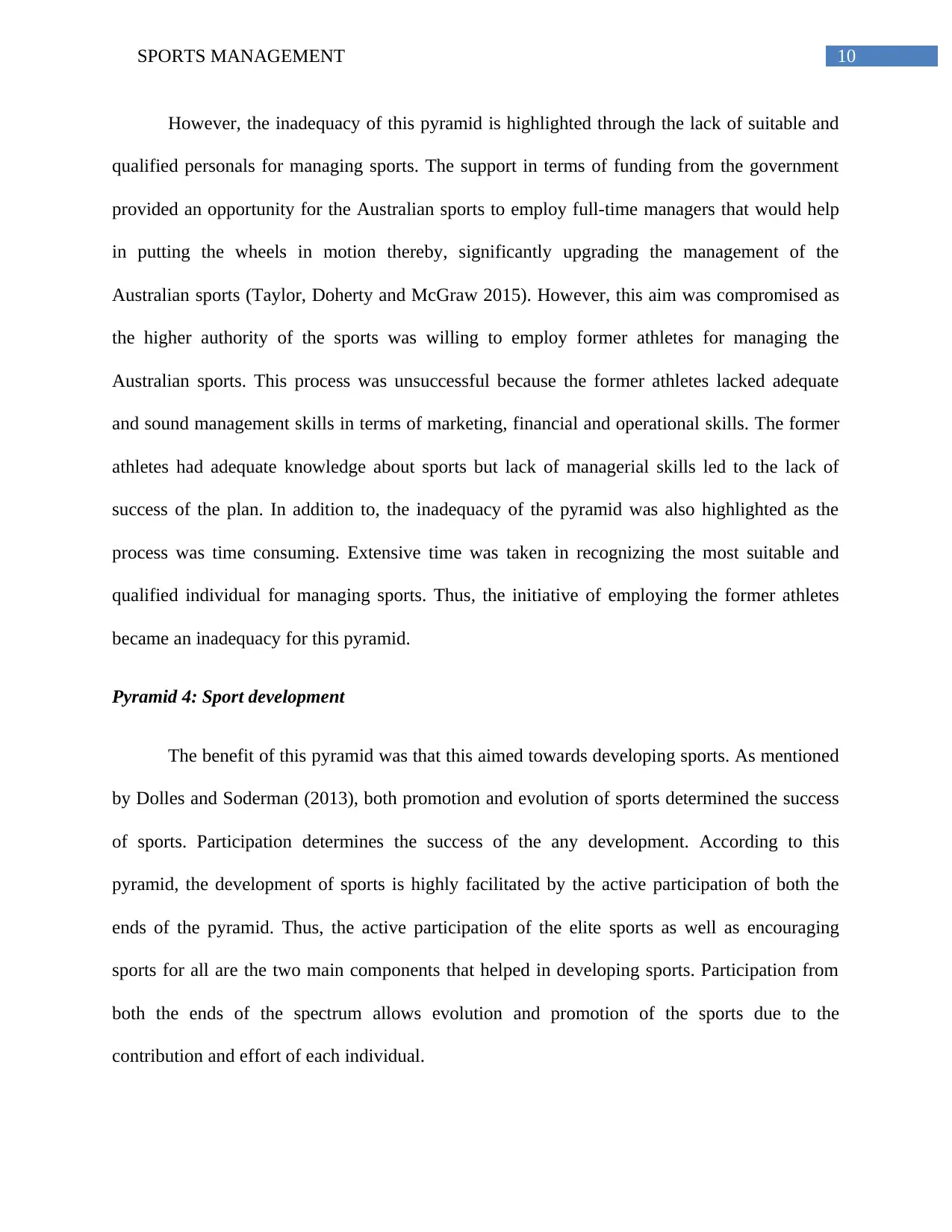
10SPORTS MANAGEMENT
However, the inadequacy of this pyramid is highlighted through the lack of suitable and
qualified personals for managing sports. The support in terms of funding from the government
provided an opportunity for the Australian sports to employ full-time managers that would help
in putting the wheels in motion thereby, significantly upgrading the management of the
Australian sports (Taylor, Doherty and McGraw 2015). However, this aim was compromised as
the higher authority of the sports was willing to employ former athletes for managing the
Australian sports. This process was unsuccessful because the former athletes lacked adequate
and sound management skills in terms of marketing, financial and operational skills. The former
athletes had adequate knowledge about sports but lack of managerial skills led to the lack of
success of the plan. In addition to, the inadequacy of the pyramid was also highlighted as the
process was time consuming. Extensive time was taken in recognizing the most suitable and
qualified individual for managing sports. Thus, the initiative of employing the former athletes
became an inadequacy for this pyramid.
Pyramid 4: Sport development
The benefit of this pyramid was that this aimed towards developing sports. As mentioned
by Dolles and Soderman (2013), both promotion and evolution of sports determined the success
of sports. Participation determines the success of the any development. According to this
pyramid, the development of sports is highly facilitated by the active participation of both the
ends of the pyramid. Thus, the active participation of the elite sports as well as encouraging
sports for all are the two main components that helped in developing sports. Participation from
both the ends of the spectrum allows evolution and promotion of the sports due to the
contribution and effort of each individual.
However, the inadequacy of this pyramid is highlighted through the lack of suitable and
qualified personals for managing sports. The support in terms of funding from the government
provided an opportunity for the Australian sports to employ full-time managers that would help
in putting the wheels in motion thereby, significantly upgrading the management of the
Australian sports (Taylor, Doherty and McGraw 2015). However, this aim was compromised as
the higher authority of the sports was willing to employ former athletes for managing the
Australian sports. This process was unsuccessful because the former athletes lacked adequate
and sound management skills in terms of marketing, financial and operational skills. The former
athletes had adequate knowledge about sports but lack of managerial skills led to the lack of
success of the plan. In addition to, the inadequacy of the pyramid was also highlighted as the
process was time consuming. Extensive time was taken in recognizing the most suitable and
qualified individual for managing sports. Thus, the initiative of employing the former athletes
became an inadequacy for this pyramid.
Pyramid 4: Sport development
The benefit of this pyramid was that this aimed towards developing sports. As mentioned
by Dolles and Soderman (2013), both promotion and evolution of sports determined the success
of sports. Participation determines the success of the any development. According to this
pyramid, the development of sports is highly facilitated by the active participation of both the
ends of the pyramid. Thus, the active participation of the elite sports as well as encouraging
sports for all are the two main components that helped in developing sports. Participation from
both the ends of the spectrum allows evolution and promotion of the sports due to the
contribution and effort of each individual.
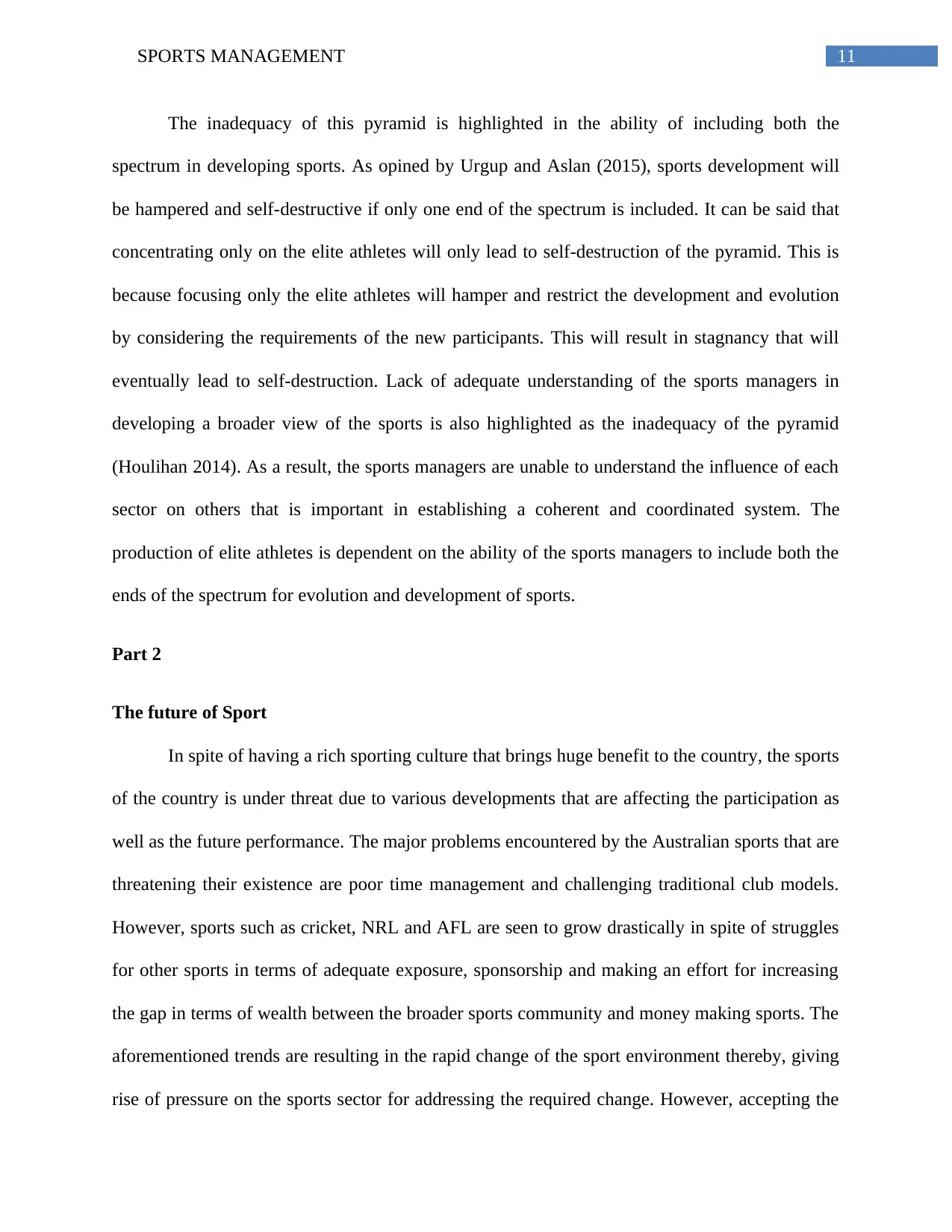
11SPORTS MANAGEMENT
The inadequacy of this pyramid is highlighted in the ability of including both the
spectrum in developing sports. As opined by Urgup and Aslan (2015), sports development will
be hampered and self-destructive if only one end of the spectrum is included. It can be said that
concentrating only on the elite athletes will only lead to self-destruction of the pyramid. This is
because focusing only the elite athletes will hamper and restrict the development and evolution
by considering the requirements of the new participants. This will result in stagnancy that will
eventually lead to self-destruction. Lack of adequate understanding of the sports managers in
developing a broader view of the sports is also highlighted as the inadequacy of the pyramid
(Houlihan 2014). As a result, the sports managers are unable to understand the influence of each
sector on others that is important in establishing a coherent and coordinated system. The
production of elite athletes is dependent on the ability of the sports managers to include both the
ends of the spectrum for evolution and development of sports.
Part 2
The future of Sport
In spite of having a rich sporting culture that brings huge benefit to the country, the sports
of the country is under threat due to various developments that are affecting the participation as
well as the future performance. The major problems encountered by the Australian sports that are
threatening their existence are poor time management and challenging traditional club models.
However, sports such as cricket, NRL and AFL are seen to grow drastically in spite of struggles
for other sports in terms of adequate exposure, sponsorship and making an effort for increasing
the gap in terms of wealth between the broader sports community and money making sports. The
aforementioned trends are resulting in the rapid change of the sport environment thereby, giving
rise of pressure on the sports sector for addressing the required change. However, accepting the
The inadequacy of this pyramid is highlighted in the ability of including both the
spectrum in developing sports. As opined by Urgup and Aslan (2015), sports development will
be hampered and self-destructive if only one end of the spectrum is included. It can be said that
concentrating only on the elite athletes will only lead to self-destruction of the pyramid. This is
because focusing only the elite athletes will hamper and restrict the development and evolution
by considering the requirements of the new participants. This will result in stagnancy that will
eventually lead to self-destruction. Lack of adequate understanding of the sports managers in
developing a broader view of the sports is also highlighted as the inadequacy of the pyramid
(Houlihan 2014). As a result, the sports managers are unable to understand the influence of each
sector on others that is important in establishing a coherent and coordinated system. The
production of elite athletes is dependent on the ability of the sports managers to include both the
ends of the spectrum for evolution and development of sports.
Part 2
The future of Sport
In spite of having a rich sporting culture that brings huge benefit to the country, the sports
of the country is under threat due to various developments that are affecting the participation as
well as the future performance. The major problems encountered by the Australian sports that are
threatening their existence are poor time management and challenging traditional club models.
However, sports such as cricket, NRL and AFL are seen to grow drastically in spite of struggles
for other sports in terms of adequate exposure, sponsorship and making an effort for increasing
the gap in terms of wealth between the broader sports community and money making sports. The
aforementioned trends are resulting in the rapid change of the sport environment thereby, giving
rise of pressure on the sports sector for addressing the required change. However, accepting the
⊘ This is a preview!⊘
Do you want full access?
Subscribe today to unlock all pages.

Trusted by 1+ million students worldwide
1 out of 30
Your All-in-One AI-Powered Toolkit for Academic Success.
+13062052269
info@desklib.com
Available 24*7 on WhatsApp / Email
![[object Object]](/_next/static/media/star-bottom.7253800d.svg)
Unlock your academic potential
Copyright © 2020–2025 A2Z Services. All Rights Reserved. Developed and managed by ZUCOL.